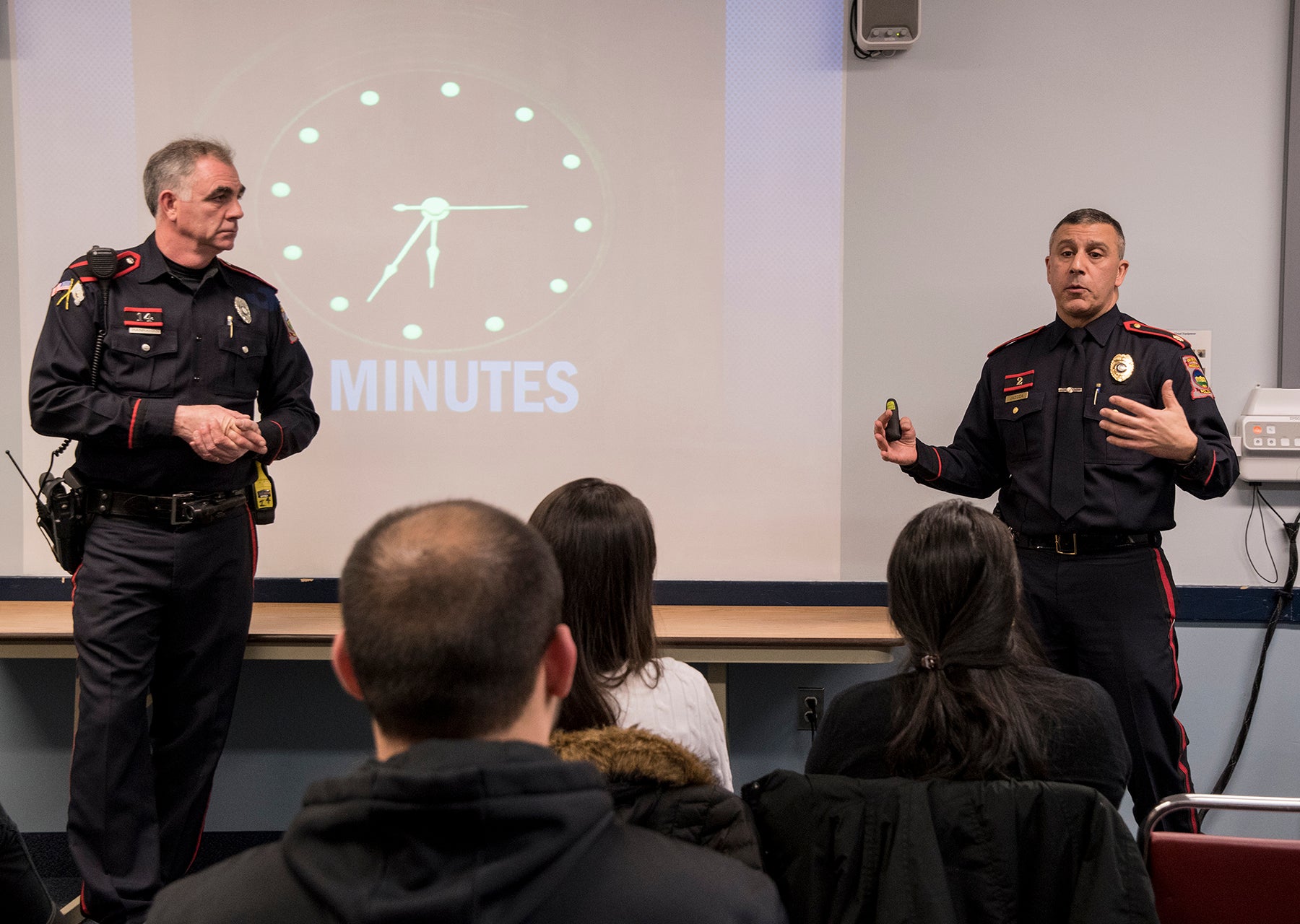KINGSTON, R.I., March 14, 2018 — The school shooting in Parkland, Fla., on Feb. 14 that left 17 dead has captured and sustained the nation’s attention in ways that previous shootings has not. But that massacre is not what led the University of Rhode Island’s Department of Public Safety to offer active shooter training to faculty, staff and students.
The University has provided its officers with such training for a number of years, and the department leads programs for police departments in local municipalities and at other universities. Expanding into training sessions for “civilians” simply made sense, said Maj. Michael Jagoda. “We are the model in the state for active shooter training,” he noted.
When the department announced community trainings in early March, demand was immediate, and additional 90-minute sessions have been scheduled to accommodate the interest.
URI Community Police Officer Paul Hanrahan begins a session by playing video and audio from the recent Florida shooting and the 1999 shooting at Columbine High School in Colorado that killed 13 and changed how police respond. The audience listens to a nearly five-minute recording of a dispatcher speaking to Columbine’s increasingly frantic librarian as sporadic gunfire can be heard in the background.
The dispatcher asks the librarian to describe the shooters and suggests she go lock the door while students hide under desks. Meanwhile, first responders surround the school, waiting to enter in the hopes of talking the student gunmen into surrendering.
“There is no more waiting. When the police arrive, they go right in, by any means necessary,” said Hanrahan, who noted that a typical mass shooting (defined as an incident with four or more casualties) lasts just seven to nine minutes.
Research shows that mass shooters have certain traits in common: 95 percent are male; they seek to inflict the highest number of casualties in the shortest amount of time; they are not interested in negotiation; and they are fully prepared to die, Hanrahan said. Schools, movie theaters and concert halls are prime targets because so many people are gathered in one place, with limited escape routes.
With that in mind, Hanrahan and Jagoda introduced participants to tactics for surviving a mass shooting: Avoid, Deny, Defend, guidelines established by the Advanced Law Enforcement Rapid Response Training Program at Texas State University, which trains officers around the nation.
“We are going to show you techniques that are going to improve your chances of surviving an active shooter situation,” Hanrahan told the audience of more than two dozen people.
He and Jagoda outlined each tactic and emphasized how hiding behind furniture or in closets is no longer recommended. “Hiding is not the answer. If you are hiding, you likely are not going to survive,” Hanrahan emphasized. He later told the group how the rate of survivability at the 2007 Virginia Tech University shooting increased in the classrooms where students either fled by jumping out windows or blockaded the door with heavy furniture, denying the gunman access.
The second a person hears gunfire or is alerted to the presence of a violent intruder, the best thing to do is to flee immediately and get as far away as possible, Hanrahan said.
If escape is not possible, the next best option is to deny access. Room doors should be locked and barred, lights turned off and cell phones silenced. Those in the room should line up along a wall out of sight of the gunman if he peers in a door window, the officers advised.
If the intruder gains access, everyone must shift to self defense, using whatever is on hand as weapons. “Go for the weaknesses — eyes, throat, groin,” Hanrahan said. “You are fighting for your life, and you have the legal right to defend yourself.”
He also said people must always be thinking of a backup plan. If the gunman is outside your door, consider jumping out a window. You may get hurt, but you are less likely to die than if you are shot, he said.
“It all comes down to shaving off seconds,” Jagoda said. “Seconds save lives.”
He and Hanrahan stressed that being aware of your surroundings every day, having a plan for quickly escaping a building or area you frequent, alerting authorities to a person’s troubling behavior — whether on social media or face-to-face — can help keep everyone safe.
“If you know what to do, it can help us save lives,” Hanrahan said. “You are not helpless. Don’t ever give up.”

